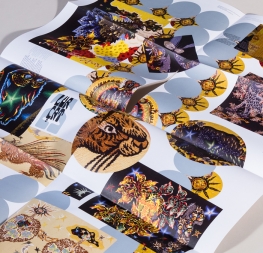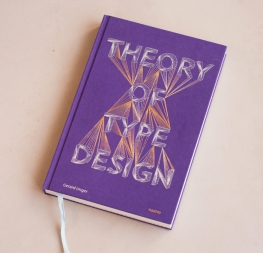One aspect of modern art which had a lasting influence on Unger's designs is pure form, as a consequence of reduction and abstraction. Artists, such as the sculptors Constantin Brancusi (1867–1957) and Alexander Calder (1878–1976), have left many examples, as has, among others, the painter Ellsworth Kelly (1923). His Blue Curve (1982) (7) and drawings of plants and leaves can be related to the shapes of the spaces within and between Unger's letters, as well as with parts of the letters themselves.
Apart from being influenced by movements in the arts and design, twentieth-century type designers were often in search of purely practical solutions, such as fitting out type to survive the heavy conditions of newspaper production, or making type simple, sturdy and friendly, for example for early readers. Taken together, such solutions can be labeled as ‘typographical pragmatism’ — a view of the field whose effects can also be discerned in his work. Excelsior (1931), by Chauncey Griffith (1879–1956), is an example of this pragmatic approach, as is Century Schoolbook (1923) by Morris Fuller Benton (1872–1948). The design of Alverata is also influenced by the work of some famous predecessors, such as William Addison Dwiggins (1880–1956, e.g. Electra, 1936) and Roger Excoffon (1910–1983, e.g. Antique Olive, 1960–70).
After 1945 Modernism and Modern Classicism were often intermingled, but the old tenets continued to survive and towards the end of the fifties Modernism made a comeback. Under the influence of societal change, this revitalized Modernism came to be overshadowed by much more informal typography, boosted by the arrival of, for example, small printing machines, during 1970s. This trend was in turn reinforced by the arrival of small computers which could run programs that enabled the owner to create not only his own types, but also his own complete graphic design. What followed was a constant succession of approaches to type design, typography and graphic design, culminating in the final decade of the twentieth century with the virtual abandonment of established typographical patterns.
Following the waning of this movement at the beginning of the twenty-first century, it is possible to discern a number of principal currents in type design. Many designers today are continuing to take complete ownership of the letterforms and subject them to far-reaching personal rearrangement. Meanwhile, however, individual interests have been joined by growing interest in collaboration between designers and extending typographic combinations, for example bringing together scripts from differing cultures — Asiatic, say, together with Latin. Alongside undiminished interest in classical serifed types, sans serifs, often neutral in character, steadily gain ground. We have custom types: fonts, designed for businesses and organizations.
There is also the ‘early twenty-first-century model’, whose letters have been brought closer together in the horizontal dimension, some narrow letterforms being widened and some wide letters being narrowed. The difference between thick and thin is slight, and the serifs are usually short and sturdy. To these basic characteristics designers often add strong, personal features. The advantage of letterforms like these is that they can work throughout the spectrum from very large to very small sizes, plus they can be used with virtually all technologies and in every medium: from ink jet and laser printers to high-quality offset; on smooth and rough paper; and on monitors and displays both old and new, big and small. It is a robust and flexible model whose origins lie in the twentieth century, for example in typewriter and newspaper faces. Since the beginning of the twenty-first century it has increasingly been the starting point for type designers.
The large type family is another important development. Serifed letterforms and sans serifs have been combined and mixed from early in the twentieth century. Now, not only are different scripts joined, such as Latin, Greek, Cyrillic or Devanagari, but also formal, informal and even unconventional versions. The concept of the large type family is sometimes the subject of experimentation, as, for example, having a combination of several italics only, upright and slanted, condensed and wide.(2)
Yet there is at present (2014) no single main development, no dominating style. Type design goes, like all design, in many different directions, often as individual approaches and as experimentation. The experiments are aimed at answering questions such as: will the continuing migration by readers from paper to screen change reading habits and perhaps letterforms as well, or: is it possible to design small and very legible letterforms for substantial amounts of text on the screens of mobile devices?
With its Incises class, Maximilen Vox’s (1894–1974) typeface classification (1954) offers the surprising possibility of bringing Romanesque and modern letterforms together in a single category and a single design. Incises (or glyphic letterforms) are reminiscent of letters chiseled in stone. It is a small group of type designs, including Albertus (1938) by Berthold Wolpe (1905–1989) and Optima (1958) by Hermann Zapf (1918). Unger's early work Amerigo (1986) fits into this category too.

















